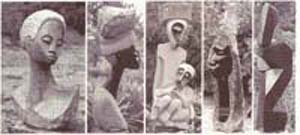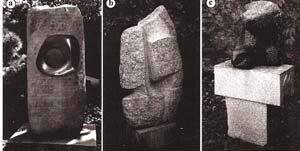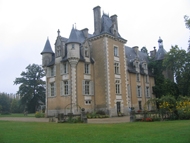Home » Journal Articles » Travel » Art in Other Places: Zimbabwean Sculpture in Singapore and South Africa – May/June 1999
In March and April 1998, I visited two large outdoor exhibitions of stone sculptures from Zimbabwe-one in Singapore and the other in South Africa. Together, those shows demonstrated that Zimbabwean sculpture is amazing, artistically and in terms of organization and marketing. The exhibition in Singapore was at Fort Canning, a large park developed from a old British military base on a hill in the centre of the city. The 50 sculptures were arranged impressively over a football- field-sized area on the dome of the hill among open grassy areas, trees, pre- WWII cannon emplacements, heavy concrete abutments, and walkways. Pieces ranged in size from about 20 inches high to 8 feet or more, with most being larger than 3 feet high. Nearly all were human figures, although there were also a few animal (e.g. monkey) or animist figures, and there was only one geometric abstraction in both shows. I think the collection may be housed permanently in Singapore, although finding information about that was difficult so I’m not sure.

The South African exhibition in particular blew me away. That show was larger than the other by half, it included some even larger pieces, and was of higher and more consistent quality. It was there for only a few days on a trip to Germany. In terms of the depth and power of my experience of art and my appreciation of artists, that show was equal to any experience I have ever had, anywhere or any time. Part of the magic was in the site, no doubt, for to visit Kirstenbosch National Botanical Garden even with no exhibition at all would have been a treat. It is a large mosaic of manicured lawns, incredible installations of shrubs and flowers, and several lushly vegetated watercourses, all sloping away from the nearby cliffs of Table Mountain, in the suburbs of Capetown. The park is stunning in its beauty, and the sculptures made it even more so. Good sculpture becomes more beautiful in beautiful surroundings, and the surroundings become more beautiful as well. This sculpture is good!
Even in a purely technical sense, most of the work in both shows exemplifies Bill Reid’s idea of the well made object. Given the tools and techniques, the range of materials, and the time these artists have to work with, most of them made the most of what they had. Their use of texture is one of many good examples’ and balance is another. Several works use the full range of textures that can be achieved in the material, and they use it effectively. Although most show neither polished, highly reflective surfaces nor weathered stone, rough and untouched from when the boulders were discovered in the field, some display both extremes of texture and several more textures in between. A good example is a woman walking with a large load on her head. She is carved with five distinct textures and five resulting colors, each of them distinct and each powerful in its evocation of perceptions and emotions in this human observer.

And balance! Let me tell you about balance. Everywhere that I went in the countryside, real women carried large loads on their heads, always with amazing grace. Whether standing talking with each other or moving over the landscape, they were always in balance; if not they would tire easily or fall. Loads more than a little out of balance would crash to the ground, and it would take increasingly more effort to keep them up as they fell. And so do the Zimbabwean women of stone carry their Burdens with grace. One balances an immense block of stone on her head while attending to a baby on her lap, serenely, as if in meditation. Somehow, she invites me to join her by entering a peaceful, meditative state of my own, and I do. Some time later I snap out of it, realize that I’m looking at a rock and not every real woman in the Third World, and drift on to the next encounter. That woman moves gracefully across the gentle landscape of Kirstenbosch, carrying a heavy bag of something very much worth carrying. She may not be resting, but she is at peace and she invites me to experience my own quietness and strength. Again my experience is real; it is not only that T am watching a real woman do her work but in some sense I am her and I am the work. What is it about the very finest art that invites us to forget that it is art, forget that we are observing it, and lose all track of time? This is what we seek, in our experience of art as ln our experience of Iiving, and I want you to know that I found it at Kirstenbosch!
In both shows the focus was clearly on the art and not on the artists; with a few exceptions, the works were unattributed. Artists’ names were nowhere to be seen, although in both places they were available for the asking. In asking at Kirstenbosch, I entered a fascinating conversation with the main organizer (he also set up the Singapore show). He told me that the artists work as a co-op, and that it is very much a matter of making a living for them. They make and sell stuff, and they must do that or starve. It is work, not recreation. The consistently and increasingly high artistic quality of the work directly reflects better financial returns for better art in Europe. The artists are aware of the (mainly Western) issue of attribution, and know that sometime soon they will be selling their names as well as their work. But I got the impression that that is all part of a large-scale marketing plan and it will come when they consider it time. Because this man was an organizer and not an artist, though, I could not be sure what an artist would have said.
With that perspective I stepped into the garden, where two women squatted, demonstrating on life-sized heads with primitive hand tools. Neither spoke English, and both were fully absorbed in their work. They carved completely freely and spontaneously, developing the forms as they went and taking full advantage of the shapes of the stones they worked with. Neither was in any hurry to break the skin of the highly weathered rock; they worked on the parts they were working on and completely ignored the rest except as it became necessary. And as with so many finished sculptures in both shows, both left large areas untouched. I mentioned this above in terms of design and expressive power. Here I will comment about it briefly here in terms of efficiency, in terms of making a living. Even the tough economic constraints under which art as a profession must emerge in the Third World, it should be no surprise that textures tend toward the rough end of the spectrum. If you are poor and pressed for time to make a living, it makes sense to get the most bucks for the bang, so to speak, and minimize the amount of work. Only one piece in both entire sets was entirely polished: the geometric human abstraction pictured. That is amazing considering the finish fetish that consumes so many of us here in the West, including me.
What a way to spend an afternoon!





We need some kind of descriptive text here.